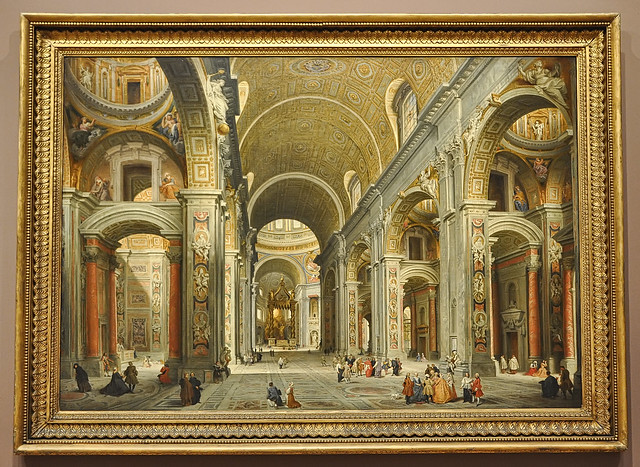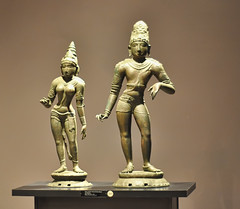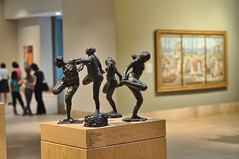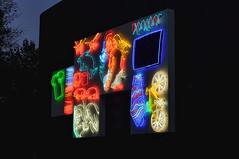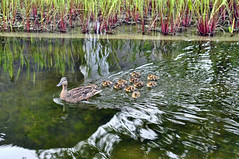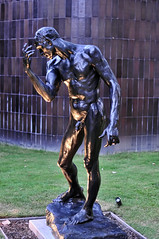Norton Simon Museum
The Norton Simon Museum is an art museum located in Pasadena, California. It was previously known as the Pasadena Art Institute and the Pasadena Art Museum and displays numerous sculptures on its grounds.
Overview
The Norton Simon collections include: European paintings, sculptures, and tapestries; Asian sculptures, paintings, and woodblock prints. Outside sculptures surround the museum, with notable Rodin sculptures near its entrance and other sculptures along Colorado Boulevard and in a landscape setting around a large pond. The museum contains the Norton Simon Theater which shows film programs daily, and hosts lectures, symposia, and dance and musical performances year-round. The museum is located on Colorado Boulevard along the route of the Tournament of Roses's Rose Parade, where its distinctive, brown tile exterior can be seen in the background of television broadcasts.
History
After receiving approximately 400 German Expressionist pieces from collector Galka Scheyer in 1953, the Pasadena Art Institute changed its name to the Pasadena Art Museum in 1954 and occupied the Chinoiserie-style "The Grace Nicholson Treasure House of Oriental Art" building (now the Pacific Asia Museum) on North Los Robles Avenue until 1970. The museum filled a void, being the only modern art museum between San Francisco and La Jolla in California at the time. It was renowned for progressive art exhibits and supported the work of local contemporary artists such as Helen Lundeberg, John McLaughlin, and Sam Francis. In 1962, curator Walter Hopps arrived from the Ferus gallery, organizing an early Pop art show in 1962 and a Marcel Duchamp retrospective in 1963, as well as solo shows of the work of Kurt Schwitters and Joseph Cornell.
Hopps later drew up a short list of California architects for a new museum building, including Richard Neutra, Charles Eames, John Lautner, Craig Ellwood, and Thornton Ladd. Hopps insisted on a local architect because he expected a high level of interaction throughout the design process. A new Pasadena Art Museum building was completed in 1969, designed by Pasadena architects Thornton Ladd and John Kelsey of the firm Ladd & Kelsey. General contractor selected to build the museum was Del E. Webb Corporation. The distinctive and modern curvilinear exterior facade is faced in 115,000 glazed tiles, in varying rich brown tones with an undulating surface, made by renowned ceramic artisan Edith Heath. Hopps resigned before the museum opened.
In the early 1970s, due to an ambitious schedule of exhibits and the new building project, the museum began to experience serious financial hardships. By that time industrialist Norton Simon, who had risen to become one of the pre-eminent art collectors in the world during the 1960s, was searching for a permanent location for his growing collection of over 4,000 objects. He was first approached for financial assistance in 1971 by trustees of the museum. In 1974, the museum and Simon came to an agreement. According to the agreed five-year plan, Simon took over an $850,000 loan on the building and other financial obligations, including a $1 million accumulated operating deficit, in return for using 75% of the gallery space for his collection. The remainder was used to display the Pasadena museum's contemporary collection. A new 10-member board of trustees was formed, consisting of four members from Simon's group, three from the Pasadena museum board and three public members nominated by Simon. Simon also became responsible for the collection and building projects; in return the museum was renamed the Norton Simon Museum and renovated at a reported cost of more than $3 million. The detailed history of that process was told by former director and art critic John Coplans (who later became an artist) in Artforum. This move, widely criticized by the local community as it represented the closing of the only contemporary art museum between San Francisco and La Jolla, led indirectly to the founding of the Museum of Contemporary Art, Los Angeles in 1979, a project largely driven by Norton Simon's sister Marcia Weisman.
Simon died in 1993, and the actress Jennifer Jones, his widow and chairwoman of the board, made corrective, conciliatory moves that have repositioned the museum and its two collections. In 1995, the museum began a major $5 million renovation with the architect Frank Gehry, a longtime trustee of the museum. The redesign resulted in a procession of medium-size, more intimate galleries with raised ceilings and improved lighting, increased rotating exhibition space, an entire floor devoted to Asian art, and restored access to the gardens. The gardens were redesigned by Power and Associates to house the 20th-century sculpture collection in an engaging setting. The new Norton Simon Theater was the final element of the renovation, designed by Gensler & Associates, and is used for lectures, film, dance performances and concerts.
Collections
The Norton Simon Museum, which comprises more than 11,000 objects, contains a significant permanent collection which is highly regarded internationally. The museum itself does not own the works it displays; instead, most of the art is on long-term loan from The Norton Simon Foundation and the Norton Simon Art Foundation, which each own different groups of artworks. As of 2014, their public filings placed the combined fair-market value of the artworks at about $2.5 billion. The museum makes relatively little effort to expand the collection amassed by its founder, but it still receives gifts. However, no more than 800 or 900 of those pieces are on display at any one time. The museum also mounts temporary exhibitions that focus on a particular artist, an art movement or artistic period, or art that was created in a specific region or country.
For more than three decades after it was founded in 1975, the Norton Simon Museum maintained a no-loans policy. In 2007, the board agreed to circulate select works to museums including the National Gallery of Art in Washington DC, saying it wanted the museum to become better known. In 2009, it entered into a reciprocal loan agreement with the Frick Collection in New York City.
Asian art
The museum has a world-renowned collection of art from South Asia and Southeast Asia, with examples of this region's sculptural and painting traditions. On display are holdings from India, Pakistan, Nepal, Tibet, Cambodia and Thailand, as well as selected works from Afghanistan, Myanmar, Bangladesh, China, Indonesia, Sri Lanka, Vietnam, and Japan. The collection is particularly rich in art from the Indian subcontinent, including monumental stone sculpture from the Kushana and Gupta periods, and a remarkable group of Chola bronzes from southern India. Selections of the museum's Rajput paintings from India, and thangkas, or Buddhist religious paintings, from Tibet and Nepal are well represented. The significant collection of Japanese woodblock prints includes objects that were formerly in the collection of Frank Lloyd Wright.
European art: 14th–16th centuries
Masterworks of the Early Renaissance, the High Renaissance and Mannerism make up the museum's extensive collection of 14th- to 16th-century European art. Exquisite works by Paolo Veneziano and Giovanni di Paolo, and an exceptional Guariento di Arpo altarpiece, anchor the museum's collection of gold-ground panel paintings. Jacopo Bassano, Botticelli, Filippino Lippi and Raphael are represented by rich oil paintings of religious scenes. Also represented are magnificent examples of such Northern European masters as Lucas Cranach the Elder, Dieric Bouts and Hans Memling. The portraits of Giorgione, Giovanni Bellini and El Greco reflect the great diversity of subject matter in the collection. Ownership of Cranach's Adam and Eve is disputed due to their history as Nazi loot.
European art: 17th–18th centuries
The museum's early Baroque paintings from Italy and Spain are represented by such noted artists as Guido Reni, Guercino, Murillo and Zurbarán. The Northern Baroque collection is profoundly expressed in the works of Peter Paul Rubens. The remarkable group of 17th-century Dutch genre, portrait and landscape paintings is crowned with three portraits by Rembrandt. Capping off the 17th century are Flemish and German still lifes, and religious landscapes by the French masters Claude Lorrain and Nicolas Poussin. The French component of the 18th century collection contains paintings by Watteau, Fragonard and Boucher, while Italy is represented with capriccios and historic glimpses into the daily life of Rome and Venice with works by Longhi, Pannini, Guardi, Canaletto, and Tiepolo.
European art: 19th century
The museum's paintings by Jean-Auguste-Dominique Ingres and Francisco de Goya mark the beginning of the 19th century and lead to superb examples of mid-century Realism executed by Jean-Baptiste-Camille Corot, Gustave Courbet and Édouard Manet. The museum has the most significant collection of Impressionist and Post-Impressionist art in Southern California. Works by Claude Monet, Pierre-Auguste Renoir and Edgar Degas, who alone is represented by over one hundred works of art, are displayed alongside the vibrant palettes of Vincent van Gogh, Paul Cézanne and Paul Gauguin. Complementing these works are Auguste Rodin's monumental bronze sculptures, displayed in the museum's front garden. Outstanding paintings by Édouard Vuillard and Pierre Bonnard lead to the doorstep of 20th-century Modernism.
Modern art
The museum has an extensive collection of Modern art, with seminal works by Pablo Picasso, Georges Braque, Henri Matisse, and Diego Rivera on permanent view. The "Galka Scheyer collection of works by the Blue Four artists" boasts paintings and works on paper by Paul Klee, Lyonel Feininger, Alexei Jawlensky, and Wassily Kandinsky. Scheyer, a German art dealer and collector who had represented these artists and settled in L.A. in 1925, left 450 works by the Blue Four and other modern artists (plus…
Hotels Norton Simon Museum
 Courtyard by Marriott Los Angeles Pasadena Old TownPasadena
Courtyard by Marriott Los Angeles Pasadena Old TownPasadena The Westin PasadenaPasadena
The Westin PasadenaPasadena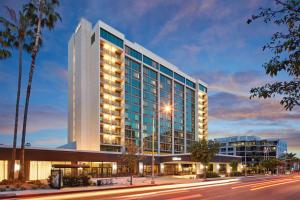 Hilton PasadenaPasadena
Hilton PasadenaPasadena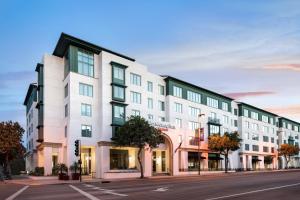 Residence Inn by Marriott Los Angeles Pasadena/Old TownPasadena
Residence Inn by Marriott Los Angeles Pasadena/Old TownPasadena Hyatt Place PasadenaPasadena
Hyatt Place PasadenaPasadena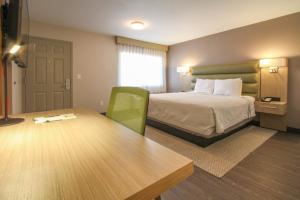 GreenTree PasadenaPasadena
GreenTree PasadenaPasadena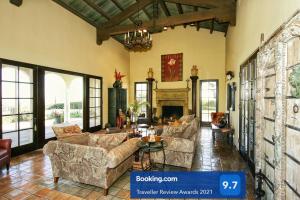 The Patrician Hollywood UniversalPasadena
The Patrician Hollywood UniversalPasadena Lovely 1B1B Home in Heart of PasadenaPasadena
Lovely 1B1B Home in Heart of PasadenaPasadena
Looking for places related to Norton Simon Museum?
Those are other destinations to find places related to Norton Simon Museum:
- Dodger Stadium
- Rose Bowl
- Huntington Library
- Pasadena City Hall
- Arroyo Seco
- Norton Simon Museum
- Millard House
- Jet Propulsion Labo…
- Fuller Theological …
- Bungalow Heaven, Pa…
- All Saints Episcopa…
- Heritage Square Mus…
- Cottage Court
- Crescenta Valley
- Hale House
- KFWB
- Cathedral High Scho…
- Atwater Avenue Elem…
- Cawston Ostrich Farm
- Alhambra High School
- California Institut…
- Alex Theatre
- Telescopio Hooker
- Arroyo Seco bicycle…
